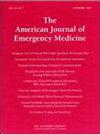Emergency medicine updates: Acute appendicitis in the adult patient
IF 2.2
3区 医学
Q1 EMERGENCY MEDICINE
引用次数: 0
Abstract
Introduction
Acute appendicitis is a condition commonly seen in the emergency department (ED). Therefore, it is important for emergency medicine clinicians to be aware of the current evidence regarding the diagnosis and management of this disease.
Objective
This paper evaluates key evidence-based updates concerning appendicitis in the adult patient for the emergency clinician.
Discussion
Acute appendicitis can present with a variety of signs and symptoms in adults, and no single history or examination finding can exclude the diagnosis of appendicitis. The presence of right lower quadrant pain or tenderness, migrating pain, Rovsing's sign, psoas sign, and obturator sign are suggestive of the diagnosis. A combination of normal white blood cell count, neutrophil distribution, and c-reactive protein suggest appendicitis is less likely. Several risk stratification tools are available, including the original and modified Alvarado score, the Appendicitis Inflammatory Response (AIR) score, the Raja Isteri Pengiran Anak Saleha Appendicitis (RIPASA) score, and the Adult Appendicitis Score (AAS). Current evidence and guidelines suggest the AIR, AAS, and RIPASA have the highest diagnostic accuracy. Patients determined to be low risk on these scores may not require further diagnostic evaluation when used with shared decision-making. Patients who are not low risk warrant further investigation. A variety of imaging tests are available, including computed tomography (CT), ultrasound (US), and magnetic resonance imaging (MRI). US or CT may be used as the first-line imaging modality in adults. US and MRI are the recommended imaging tests in pregnant females. All patients with acute appendicitis should receive surgical consultation, and antibiotics should be administered. Evidence suggests that non-operative management with antibiotics alone may be safe in select patients with uncomplicated appendicitis, particularly those without appendicolith. Surgical intervention is recommended in pregnancy.
Conclusions
An understanding of literature updates can improve the ED care of patients with appendicitis.
急诊医学更新:成人急性阑尾炎患者
急性阑尾炎是一种常见于急诊科(ED)的疾病。因此,对于急诊临床医生来说,了解目前关于这种疾病的诊断和管理的证据是很重要的。目的评价急诊临床医师对成人阑尾炎的关键循证更新。急性阑尾炎在成人中可以表现出多种体征和症状,没有单一的病史或检查结果可以排除阑尾炎的诊断。右下腹疼痛或压痛、迁移性疼痛、罗辛氏征、腰肌征和闭孔征均提示诊断。白细胞计数、中性粒细胞分布和c反应蛋白正常,提示阑尾炎的可能性较小。几种风险分层工具可用,包括原始和修改的Alvarado评分,阑尾炎炎症反应(AIR)评分,Raja Isteri Pengiran Anak Saleha阑尾炎(RIPASA)评分和成人阑尾炎评分(AAS)。目前的证据和指南表明,AIR、AAS和RIPASA具有最高的诊断准确性。在共同决策的情况下,这些评分被确定为低风险的患者可能不需要进一步的诊断评估。风险不低的患者需要进一步调查。各种成像测试是可用的,包括计算机断层扫描(CT),超声(US)和磁共振成像(MRI)。超声或CT可作为成人的一线成像方式。美国和核磁共振成像是孕妇推荐的影像学检查。所有急性阑尾炎患者均应接受外科会诊,并给予抗生素治疗。有证据表明,对于非复杂性阑尾炎患者,特别是那些没有阑尾炎的患者,单独使用抗生素进行非手术治疗可能是安全的。妊娠期建议手术干预。结论了解文献更新可提高阑尾炎患者的急诊护理水平。
本文章由计算机程序翻译,如有差异,请以英文原文为准。
求助全文
约1分钟内获得全文
求助全文
来源期刊
CiteScore
6.00
自引率
5.60%
发文量
730
审稿时长
42 days
期刊介绍:
A distinctive blend of practicality and scholarliness makes the American Journal of Emergency Medicine a key source for information on emergency medical care. Covering all activities concerned with emergency medicine, it is the journal to turn to for information to help increase the ability to understand, recognize and treat emergency conditions. Issues contain clinical articles, case reports, review articles, editorials, international notes, book reviews and more.

 求助内容:
求助内容: 应助结果提醒方式:
应助结果提醒方式:


